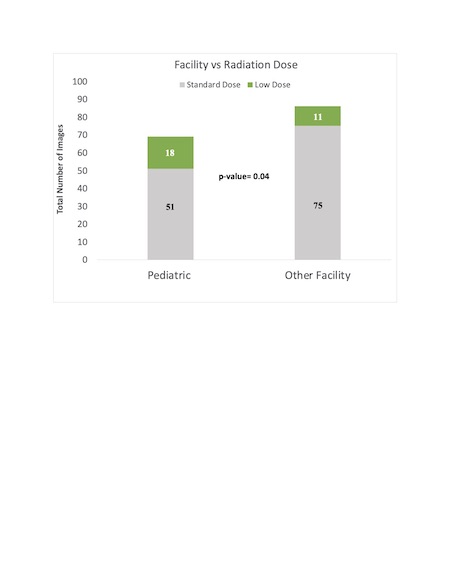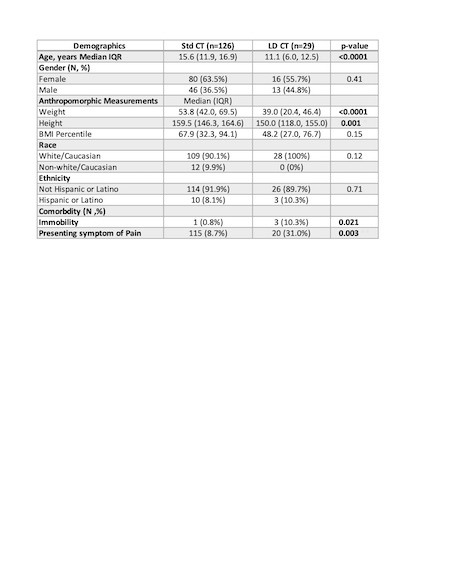Back
Poster, Podium & Video Sessions
Moderated Poster
MP17: Pediatric Urology: Upper & Lower Urinary Tract
MP17-11: Use of Low Dose Computed Tomography in Children with Nephrolithiasis: A Multi- Institutional Analysis
Friday, May 13, 2022
4:30 PM – 5:45 PM
Location: Room 225
Ashley Pittman*, Wauwatosa, WI, Neil Paloian, Madison, WI, Amy Pan, Liyun Zhang, Andrea Moyer, Robert Medairos, Pooja Thakrar, Wauwatosa, WI, Jonathan Ellison, Wauwatosa , WI
- AP
Ashley Pittman
Medical College of Wisconsin
Poster Presenter(s)
Introduction: Computed tomography (CT) may be necessary in cases of a non-diagnostic ultrasound for suspected pediatric nephrolithiasis. Low dose computed tomography (LDCT) reduces radiation exposure when this imaging is warranted. However, utilization of dose reduction strategies in children is not well described. We investigated LDCT patterns from two pediatric centers along with outside referrals, hypothesizing that LDCT scans will be utilized more frequently at pediatric centers as compared to referral centers.
Methods: A retrospective chart review of children = 17 years of age presenting with suspected index nephrolithiasis and undergoing CT at two tertiary children’s hospitals between 2013- 2019 was performed. Children with prior documented CT scans within the study period or lacking radiation dose assessment were excluded. Demographics, comorbidities, and radiation dose were extracted from the medical records. The primary outcome measure of the study is LDCT, (radiation dose <3 mGy). Radiation dose variations between centers were compared. A Mann-Whitney test was used to compare continuous variables while Chi-square test was used to compare categorical variables. The Classification and Regression Tree (CART) methodology was used to estimate the likelihood of LDCT utilization.
Results: A total of 155 individuals met inclusion criteria, with 129 (83.2%) receiving standard dose and 29 (18.7%) receiving LDCT. Univariate comparisons are listed in the table. LDCT use from pediatric versus other facilities is shown in Figure 1. CART analysis found age and body mass index (BMI) percentile to be the two most important associations for LDCT (learn area under the curve (AUC)=0.90 and test AUC=0.79).
Conclusions: Pediatric facilities utilized LDCT more frequently, although age and BMI may also influence imaging choices. An understanding of the factors associated with dose reduction in CT will impact future efforts to explore optimum imaging stewardship in pediatric nephrolithiasis.
Source of Funding: Urology Care Foundation Summer Medical Student Grant


Methods: A retrospective chart review of children = 17 years of age presenting with suspected index nephrolithiasis and undergoing CT at two tertiary children’s hospitals between 2013- 2019 was performed. Children with prior documented CT scans within the study period or lacking radiation dose assessment were excluded. Demographics, comorbidities, and radiation dose were extracted from the medical records. The primary outcome measure of the study is LDCT, (radiation dose <3 mGy). Radiation dose variations between centers were compared. A Mann-Whitney test was used to compare continuous variables while Chi-square test was used to compare categorical variables. The Classification and Regression Tree (CART) methodology was used to estimate the likelihood of LDCT utilization.
Results: A total of 155 individuals met inclusion criteria, with 129 (83.2%) receiving standard dose and 29 (18.7%) receiving LDCT. Univariate comparisons are listed in the table. LDCT use from pediatric versus other facilities is shown in Figure 1. CART analysis found age and body mass index (BMI) percentile to be the two most important associations for LDCT (learn area under the curve (AUC)=0.90 and test AUC=0.79).
Conclusions: Pediatric facilities utilized LDCT more frequently, although age and BMI may also influence imaging choices. An understanding of the factors associated with dose reduction in CT will impact future efforts to explore optimum imaging stewardship in pediatric nephrolithiasis.
Source of Funding: Urology Care Foundation Summer Medical Student Grant



.jpg)
.jpg)